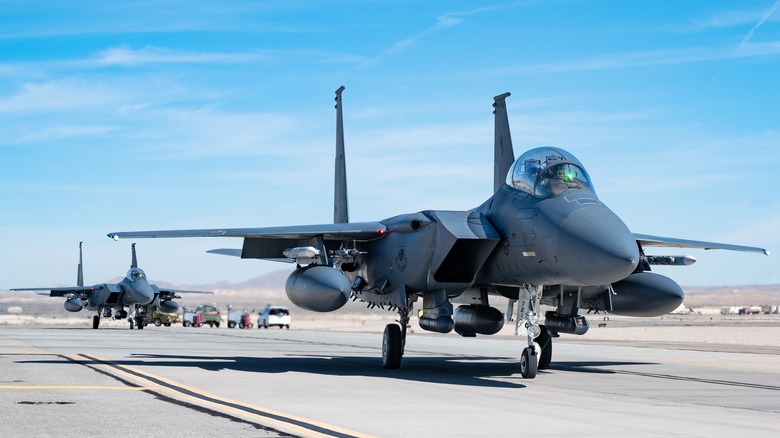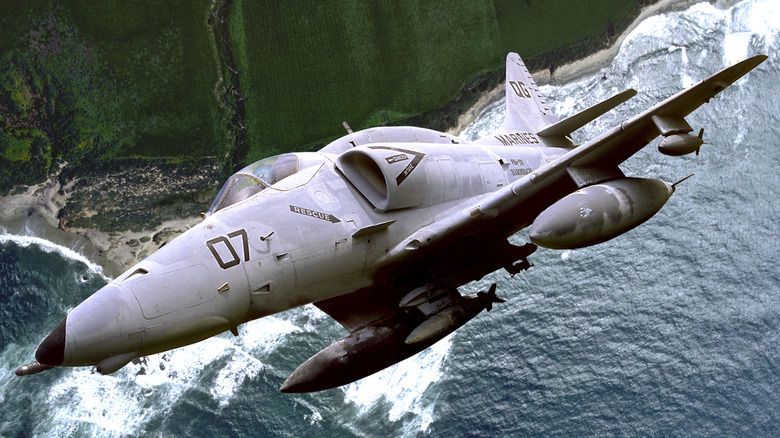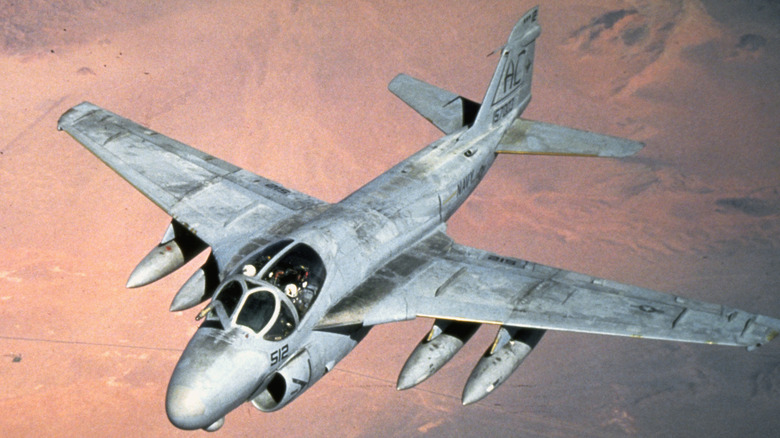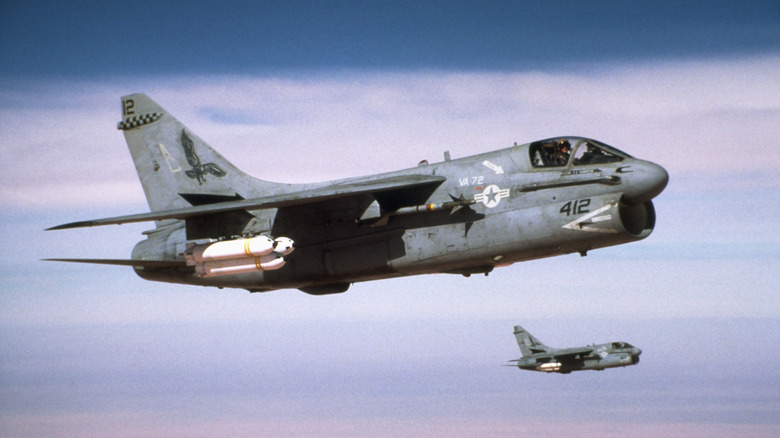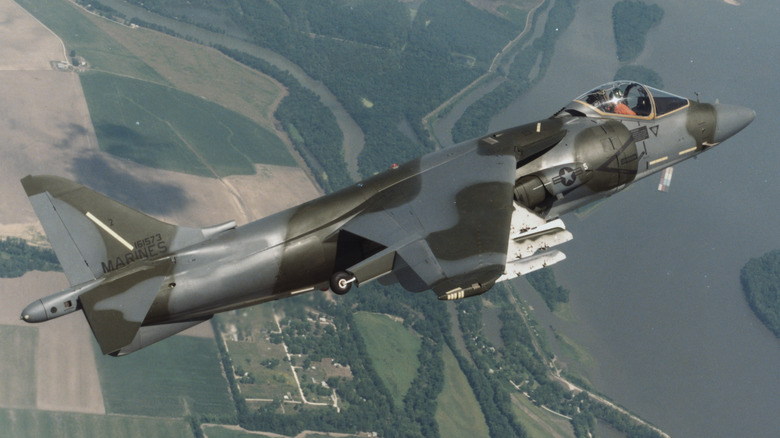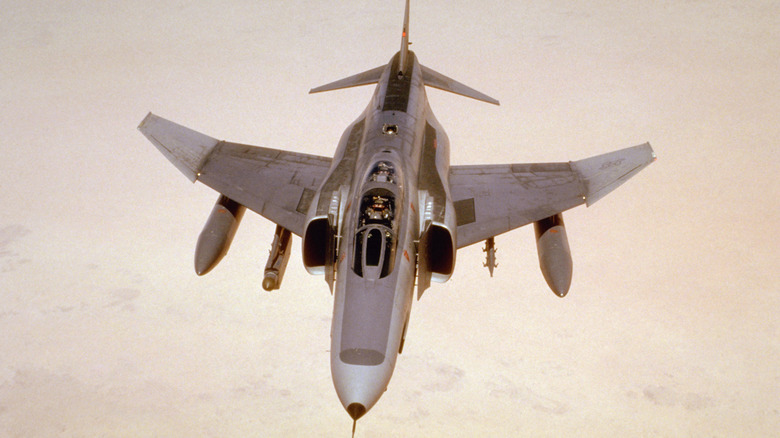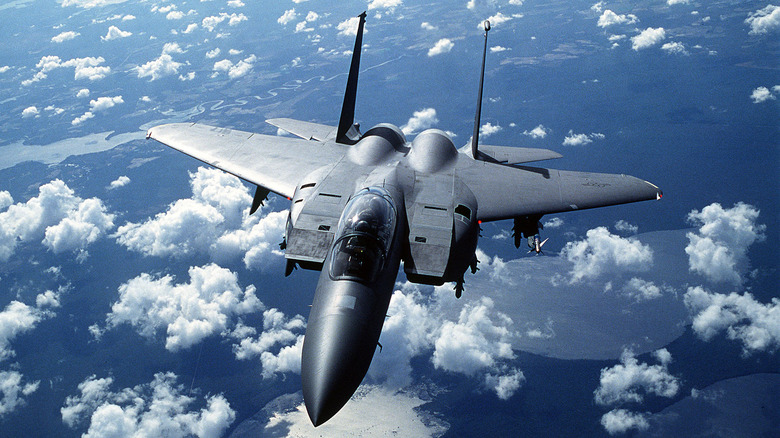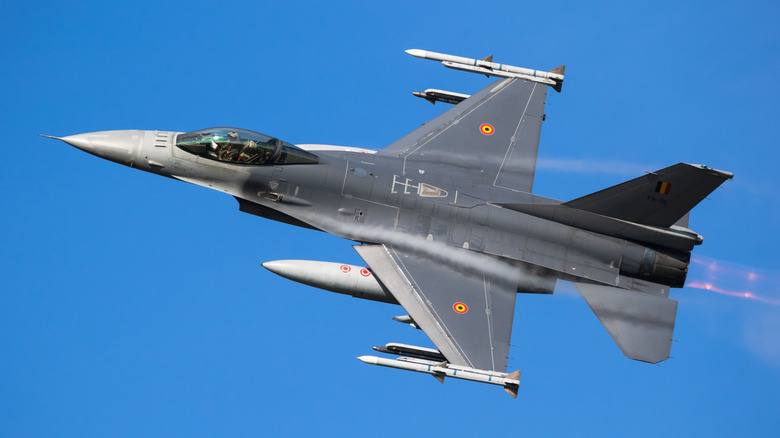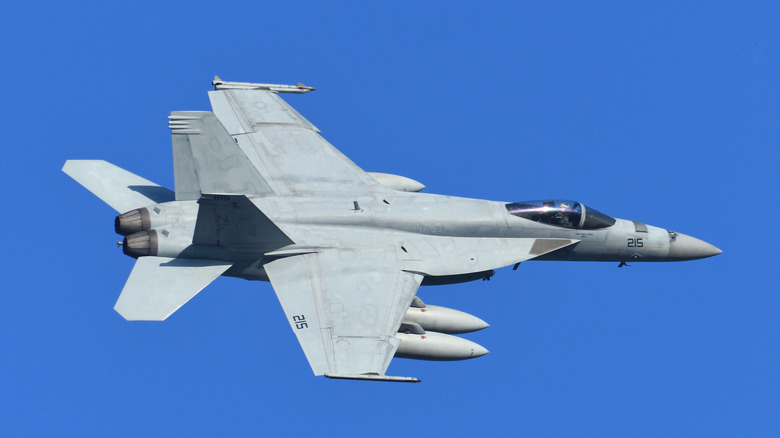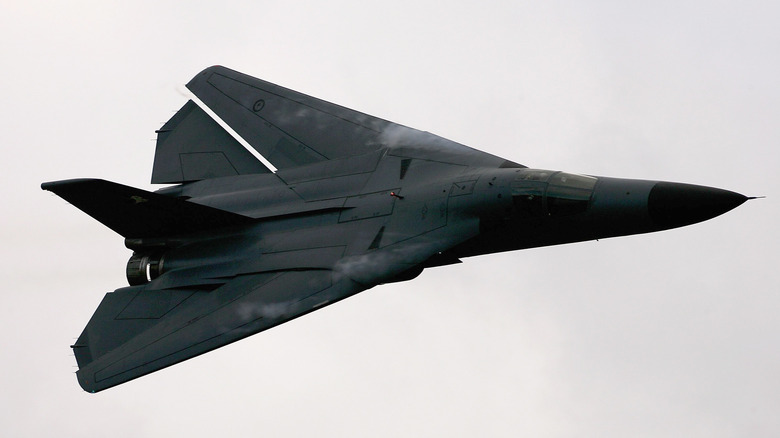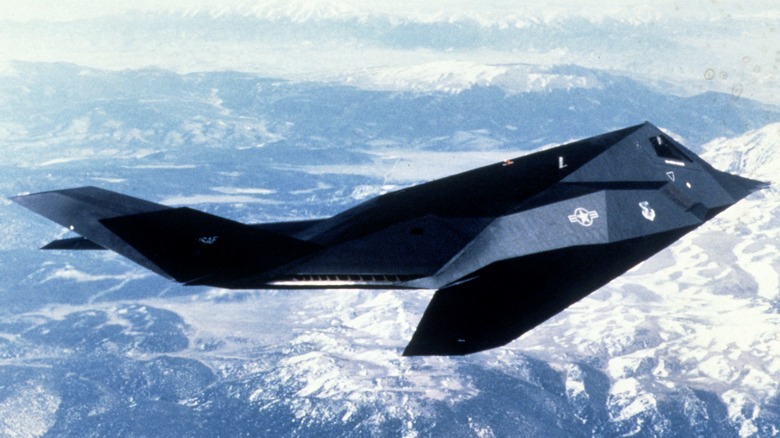Every American Aircraft That Can Carry Tactical Nuclear Bombs
When we think about nuclear weapons, most of us likely think of Little Boy and Fat Man, the twin atomic bombs that the U.S. dropped on Hiroshima and Nagasaki. Both of these bombs were huge, requiring hulking Boeing B-29 Superfortress bombers to fly them into position, and packed enough power to lay waste to both cities.
As impressive as the destructive potential of a strategic nuclear bomb is, they're not necessarily the best option for battlefield use, where friendly fire is a genuine risk. That's where tactical (or nonstrategic) nuclear weapons come into the picture. These are less powerful devices for targeted attacks against enemy troops or facilities while minimizing fallout. As you might imagine, these require precision targeting and a wholly different aircraft than conventional bombers.
The U.S. military has had many nuclear-capable fighter planes, most of which are small and agile aircraft — especially compared to the Boeing B-29 — making them perfect for the targeted nature of tactical nuclear weapons. At least, they are in theory, as none of the world's governments have ever used a tactical nuke in combat. However, if the U.S. ever had to, it'd likely use one of these aircraft.
Douglas A-4 Skyhawk
The Douglas A-4 Skyhawk is a small, single-seater light attack plane that was a mainstay of the U.S. Navy's aerial forces for decades, entering service with Attack Squadron 72 in 1956 and retiring 47 years later in 2003 with almost 3,000 units built between its debut and 1979. The Skyhawk has several claims to fame, including recording more combat missions than all other U.S. Navy aircraft in the Vietnam War. It also secured a place in pop culture lore by being one of the fighter jets featured in 1986's "Top Gun," starring in the all-important training scenes.
The A-4 Skyhawk was an agile and speedy plane with impressively compact dimensions. Notably, its wingspan was only 27 feet and 6 inches, which is tiny by almost any standards. Despite its small frame, the A-4 Skyhawk could carry an impressive amount of artillery, particularly in its A-4C and A-4E guises. These had three and five weapons stations, respectively, allowing for over 8,000 pounds of munitions — including the B43 nuclear bomb.
Unlike most planes on this list, we have records of an A-4 Skyhawk carrying a tactical nuclear weapon, albeit not in combat. Unfortunately, we only know this because this particular A-4 Skyhawk was involved in a Broken Arrow incident. On December 5, 1965, the A-4 in question, along with its B43 nuclear bomb and pilot, rolled off the USS Ticonderoga into the Philippine Sea during a routine training exercise. None were ever seen again.
Grumman A-6 Intruder
Grumman's A-6 Intruder is a two-seat fighter plane born out of a 1957 Navy aircraft specification requiring a plane capable of close air support and long-range air-to-ground missions in all weather. Fresh from its experience in the Korean War, the Navy needed an aircraft that could fly under enemy radar and carry out precision strikes on mobile ground targets. Grumman's design fit the bill precisely.
The A-6 Intruder was the first-ever all-weather capable bomber in the world, with its advanced (for the time) avionics giving it an edge over older designs. The A-6 housed ground and target acquisition radar systems, feeding the information to in-cockpit CRT displays via the A-6's Digital Integrated Attack and Navigation Equipment (DIANE). The CRT displays allowed the pilots to navigate and identify targets in inclement weather and at night.
Grumman's design made its first flight in 1960, with the Navy and Marines receiving production units in 1963 and 1964, respectively. With five hardpoints and the ability to carry up to 18,000 pounds worth of munitions (including nuclear weapons), the A-6 Intruder became a vital part of the U.S. military's air forces during the Vietnam War. Despite only being involved in 20% of combat sorties, A-6 Intruders dropped almost half of the bombs U.S. forces deployed during the conflict.
The Navy retired the Grumman A-6 Intruder in 1997, with the Grumman F-14 Tomcat and McDonnell Douglas F/A-18 Hornet filling the A-6 Intruder's former combat roles.
LTV A-7 Corsair II
In 1963, the U.S. Navy needed a light attack plane to succeed the venerable Douglas A-4 Skyhawk, with the main requirements being more range and a larger payload. Companies were also required to base their design on planes already in service. Vought (later LTV) stepped up to the plate with the A-7 Corsair II, based on its already-existent F-8 Crusader design but modified to meet the Navy's requirements.
The result was a stub-nosed fighter commonly known as the SLUF, which stood for Short Little Ugly Fella — or possibly something way more vulgar. Despite not being much of a looker, however, the A-7 Corsair II fulfilled the Navy's brief capably, as the SLUF could carry 15,000 pounds of munitions — double that of the A-4 Skyhawk — and had an improved range of 3,044 miles compared to the A-4's 2,525 miles.
The A-7 Corsair II also had another significant advantage over the Skyhawk, as LTV's fighter was significantly more accurate than the A-4, thanks to its revolutionary heads-up display (HUD), complex avionics, and sensors. This accuracy would have been crucial had the A-7s been called upon to deliver the nuclear payloads for which they were eventually certified.
LTV launched the first Corsair II prototypes in 1965, with squadrons receiving production units the following year. The Corsair II and its successive versions saw heavy use in the Vietnam War, notably during 1972's Operation Linebacker. The U.S. continued to use A-7 Corsair II's over the coming decades, finally retiring them after Operation Desert Storm.
McDonnell Douglas AV-8B Harrier II
The McDonnell Douglas AV-8B Harrier II is a single-seat fighter best known for its short or vertical take-off and landing (S/VTOL) capabilities, which allowed it to take off vertically and hover much like a helicopter. While this is far from the AV-8B's only standout feature, it's undoubtedly the one that rocketed it to widespread prominence via its appearance in 1994's "True Lies".
The AV-8B Harrier II was a collaboration between McDonnell Douglas and British Aerospace, making its first flight in 1981. Boeing took over after its merger with the former and continued building the AV-8B until 2003, when the last units left the factory. The Harrier II was designed expressly for close-air support, using its S/VTOL capabilities to respond to battlefield needs quickly. However, the design allowed the Harrier II to take on interdiction and air patrol duties if needed.
Harrier IIs could carry around 9,000 pounds of combined armaments, including air-to-air, air-to-ground, anti-ship missiles, and several types of bombs. U.S. Marine Corps Harrier IIs had an extra edge in the form of the Joint Direct Attack Munition kit, which converted "dumb" free-fall bombs into guided missiles.
While the AV-8B Harrier IIs certainly had the capacity and hardpoints to carry tactical nuclear warheads if necessary, the USMC abandoned its plans to nuclear-certify the Harrier II in the mid-'80s. Whether that was due to the AV-8B Harrier II's capabilities or simply shifting political (and military) realities is, sadly, not a question we have answers to.
McDonnell Douglas F-4 Phantom II
McDonnell Douglas' F-4 Phantom II is often considered one of the most iconic fighter jets ever built, with more than 5,000 units produced between its first flight in 1958 and the final units rolling off the production line in 1979. Still, there's more to the F-4 Phantom II than the sheer number McDonnell Douglas produced for the U.S. military and other governments: The F-4 and its variants also set 16 aerial records over its lifespan, including world altitude (98,556 feet) and world speed records (1,604 mph) in 1959 and 1964, respectively.
Of course, aerial ability is only half the picture for a fighter-bomber. Thankfully, the F-4 Phantom II could also carry an impressive array of weaponry on its massive (by fighter standards) dual-seat frame. F-4s could haul up to 16,000 pounds of arms and supplies, including nuclear weapons, on its nine hardpoints. That's double what a World War II-era Boeing B-17 bomber could carry.
The F-4 Phantom II debuted during the Vietnam War, where it struggled in aerial combat against the combination of more maneuverable MiG aircraft and heavy ground flak. However, the Phantom II would play a starring role in the Middle East as the F-4 was a mainstay of the Israeli Army during the Arab-Israeli War of 1973 and would later excel as a Wild Weasel air-to-ground plane for the U.S. during the Gulf War. The U.S. retired the F-4 Phantom II in 1996, but several countries — including Turkey — still fly F-4s.
McDonnell Douglas F-15E Strike Eagle
The U.S. and Russia were involved in a constant technological arms race during the Cold War decades, with each superpower trying to gain the upper hand and showcase its technological and military superiority. The legendary McDonnell Douglas F-15 Eagle was a product of this conflict, arising from a perceived need to counter Russia's Mikoyan-Gurevich MiG-25.
The F-15 Eagle was an all-weather fighter plane first flown in 1972. It boasted excellent maneuverability (ranking as one of the fastest fighters in the world) and advanced technology, especially for its time. However, at first it was solely an air-to-air fighter. That changed in 1988 when McDonnell Douglas delivered the first production units of the new F-15E Strike Eagle. The Strike Eagle was a two-seat fighter-bomber modified to carry a massive 23,000-pound maximum payload. As of 2019, this payload could consist of all the air-to-ground missiles in the Air Force's inventory, including nuclear weapons.
Along with the huge number of potential on-board arms, the F-15E boasted complex avionics to suit its strike role. Its APG-70 radar system, for example, allowed the crew to detect ground targets over huge distances. Similarly, the low-altitude navigation and targeting infrared for night (LANTIRN) system ensured the F-15E could operate in all conditions and times of the day.
The U.S. Air Force had 219 active F-15Es as of April 2019. The F-15E is also one of the planes the U.S. National Nuclear Security Administration (NNSA) certifies to deliver the new B61-12 nuclear gravity bomb.
General Dynamics F-16 Fighting Falcon
The General Dynamics F-16 Flying Falcon has been around for a long time. General Dynamics started producing the aircraft in 1977, but Lockheed Martin still produces the F-16 as of 2024 in the form of the F-16V Block 70/72. Over 4,500 F-16s have left the factory over this nearly 50-year production span.
The F-16's longevity isn't hard to understand. It's a proven, multirole aircraft equally capable in air-to-air and air-to-ground combat scenarios, having seen action in U.S. military operations such as Desert Storm, Operation Enduring Freedom, and Operation Iraqi Freedom. It has a 500-mile range in air-to-ground strike configuration while still being able to defend itself against air threats. The F-16C and F-16D variants also have advanced avionics, such as Raytheon's AN/ASQ-213 HARM, which allow pilots to detect and identify ground targets even in non-visual conditions.
F-16 Fighting Falcons have nine hardpoints capable of carrying various armaments. The standard payload, at least as of 2021, would consist of two 2,000-pound bombs, four air-to-air missiles (AIM-20 and AIM-120), and two external fuel tanks. Nuclear weapons understandably aren't part of any standard loadout, but the F-16C/D planes are amongst the small handful of current fighter-bombers that the U.S. NNSA certifies to carry the B61-12 nuclear gravity bomb.
Beyond its combat prowess and nuclear capabilities, the F-16 is also well-remembered for being the first aircraft with an electrical (as opposed to physical) fly-by-wire control system, which almost all fighters have used since.
McDonnell Douglas F/A-18 Hornet
McDonnell Douglas' F/A-18 Hornet is a dual-purpose fighter and attack aircraft designed to serve as an attack plane for tasks such as close air support and interdiction alongside more traditional fighter duties. The Hornet first flew in 1978 and entered active service in the early 1980s before becoming an integral part of U.S. forces during Operation Desert Storm. There, the Hornets lived up to their dual billing, regularly shooting down enemy aircraft and bombing Iraqi targets all in one sortie.
Boeing's F/A-18E and F/A-18F Super Hornets entered U.S. service in 1999, with several notable improvements over the old Hornet. With a range of 1,275 nautical miles, the Super Hornets can fly further than their predecessors while also being able to carry more armaments. The Hornet and Super Hornet continue to fly as part of the U.S. aerial forces, with the latter replacing the Grumman F-14 Tomcat in active duty.
The F/A-18 Hornet and Super Hornet's nuclear capabilities are somewhat unclear. On the one hand, the U.S. NNSA doesn't list any of the Hornet planes as platforms for the B61-2 nuclear bomb. On the other hand, the Department of Defense has told the Federation of American Scientists that "there is not a requirement for the F/A-18F to be certified to carry the B61-12." So it's likely that the Hornets could carry nukes, but the U.S. has no intention of doing so. Nuclear or not, though, F/A-18s are dangerous aircraft worthy of respect.
General Dynamics F-111 Aardvark
General Dynamics' F-111 Aardvark was the product of a 1962 U.S. Department of Defense contract for a long-range, supersonic fighter. The TFX program (short for Tactical Fighter Experimental) called for a versatile aircraft capable of performing multiple roles for the U.S. Navy and Air Force. While the bidding process was not without controversy, General Dynamics eventually won out with its F-111 Aardvark.
To fulfill the Department of Defense's brief, the two-seater F-111 Aardvark featured a then-unseen variable-sweep wing, which allowed pilots to change the F-111's wing configuration in flight. This movable wing meant the F-111 was capable of wildly contrasting feats usually out of the reach of conventionally winged aircraft. For example, the F-111 was capable of short (sub-2,000 feet) takeoff with fully extended wings but could then move the wings fully back to fly at supersonic speeds.
The F-111 Aardvark could carry a significant payload, with room for a maximum of 24 conventional or nuclear weapons. Earlier versions of the F-111 also came equipped with a 20mm cannon, but later models like the F-111F replaced the cannon with an AN/AVQ-26 Pave Tack laser-guided targeting system. This Pave Tack system made the F-111F a capable all-weather bomber, and it flew over 2,400 bombing missions during Operation Desert Storm. F-111s, in general, played a massive part in the conflict, too, participating in a combined total of over 5,000 raids in the Gulf.
General Dynamics built 566 F-111s, including 106 F-111Fs, before the U.S. Air Force retired the plane in 1996.
Lockheed F-117 Nighthawk
The Lockheed F-117 Nighthawk is easily the rarest plane on this list, with only 59 units built from 1981 and 1990. Despite that, the Nighthawk is likely the only one that even non-aviation fans can identify, thanks to its unique shape and futuristic design. The F-117's flat, angular design isn't just for show, either, as the multiple panels that make up its body deflect radar signals, which, combined with the radar-absorbent material coating and fully in-board weapons and fuel tanks, made it a true stealth fighter capable of attacking ground targets while evading radar detection.
The F-117 has its roots in the Cold War, specifically a 1970s DARPA program aimed at countering advancements in surface-to-air missile (SAM) technology. It would make its first flight in 1981 but remained a secret until 1989, when two F-117s participated in Operation Just Cause. The Nighthawk also holds a near-perfect service record, with only one plane downed by enemy fire.
Despite bearing the F designation usually reserved for air-to-air fighters, the F-117 Nighthawk was exclusively an air-to-ground strike aircraft with no air-to-air munitions. The Nighthawk had two bomb bays capable of carrying up to 5,000 pounds of munitions, including the B61 nuclear bomb. In addition, all F-117s had an Aircraft Monitoring and Control (AMAC) panel that could interface directly with B61 bombs, allowing pilots to arm their payloads in flight.
